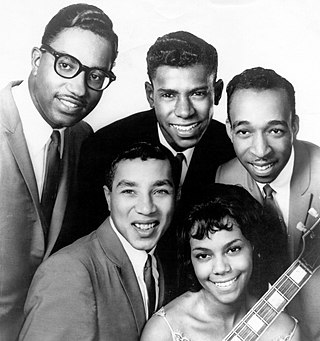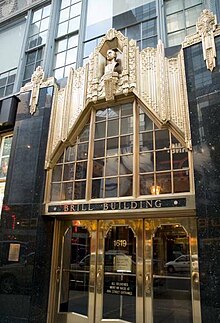
Psychedelic rock is a rock music genre that is inspired, influenced, or representative of psychedelic culture, which is centered on perception-altering hallucinogenic drugs. The music incorporated new electronic sound effects and recording techniques, extended instrumental solos, and improvisation. Many psychedelic groups differ in style, and the label is often applied spuriously.
Rock is a broad genre of popular music that originated as "rock and roll" in the United States in the late 1940s and early 1950s, developing into a range of different styles from the mid-1960s, particularly in the United States and the United Kingdom. It has its roots in 1940s and 1950s rock and roll, a style that drew directly from the blues and rhythm and blues genres of African-American music and from country music. Rock also drew strongly from genres such as electric blues and folk, and incorporated influences from jazz and other musical styles. For instrumentation, rock has centered on the electric guitar, usually as part of a rock group with electric bass guitar, drums, and one or more singers. Usually, rock is song-based music with a 4
4 time signature using a verse–chorus form, but the genre has become extremely diverse. Like pop music, lyrics often stress romantic love but also address a wide variety of other themes that are frequently social or political. Rock was the most popular genre of music in the U.S. and much of the Western world from the 1950s to the 2010s.

New York Dolls is the debut album by the American hard rock band New York Dolls. It was released on July 27, 1973, by Mercury Records. In the years leading up to the album, the Dolls had developed a local fanbase by playing regularly in lower Manhattan after forming in 1971. However, most music producers and record companies were reluctant to work with them because of their vulgarity and onstage fashion as well as homophobia in New York; the group later appeared in exaggerated drag on the album cover for shock value.

Popular music of the United States in the 1970s saw various forms of pop music dominating the charts. Often characterized as being shallow, 1970s pop took many forms and could be seen as a reaction against the high-energy and activist pop of the previous decade. It began with singer-songwriters like Carole King and Carly Simon topping the charts, while New York City saw a period of great innovation; hip hop, punk rock and salsa were invented in 1970s New York, which was also a center for electronic music, techno.

The Brill Building is an office building at 1619 Broadway on 49th Street in the New York City borough of Manhattan, just north of Times Square and further uptown from the historic musical Tin Pan Alley neighborhood. It was built in 1931 as the Alan E. Lefcourt Building, after the son of its builder Abraham E. Lefcourt, and designed by Victor Bark Jr. The building is 11 stories high and has approximately 175,000 square feet (16,300 m2) of rentable area.

Neil Sedaka is an American singer, songwriter and pianist. Since his music career began in 1957, he has sold millions of records worldwide and has written or co-written over 500 songs for himself and other artists, collaborating mostly with lyricists Howard "Howie" Greenfield and Phil Cody.
Roots rock is a genre of rock music that looks back to rock's origins in folk, blues and country music. It is seen as responses to the perceived excesses of the dominant psychedelic and the developing progressive rock. Because roots music (Americana) is often used to mean folk and world musical forms, roots rock is sometimes used in a broad sense to describe any rock music that incorporates elements of this music. In the 1980s, roots rock enjoyed a revival in response to trends in punk rock, new wave, and heavy metal music.

American rock has its roots from 1940s and 1950s rock and roll, rhythm and blues, and country music, and also draws from folk music, jazz, blues, and classical music. American rock music was further influenced by the British Invasion of the American pop charts from 1964 and resulted in the development of psychedelic rock.

Donald Kirshner was an American music publisher, music consultant, rock music producer, talent manager, and songwriter. Dubbed "the Man with the Golden Ear" by Time magazine, he was best known for managing songwriting talent as well as successful pop groups, such as the Monkees, Kansas, and the Archies.
Pop rock is a fusion genre characterized by a strong commercial appeal, with more emphasis on professional songwriting and recording craft, and less emphasis on attitude than standard rock music. Originating in the late 1950s as an alternative to normal rock and roll, early pop rock was influenced by the beat, arrangements, and original style of rock and roll. It may be viewed as a distinct genre field rather than music that overlaps with pop and rock. The detractors of pop rock often deride it as a slick, commercial product and less authentic than rock music.

Howard Greenfield was an American lyricist and songwriter, who for several years in the 1960s worked out of the famous Brill Building. He is best known for his successful songwriting collaborations, including one with Neil Sedaka from the late 1950s to the mid-1970s, and near-simultaneous songwriting partnerships with Jack Keller and Helen Miller throughout most of the 1960s.

Jack Walter Keller was an American composer, songwriter and record producer. He co-wrote, with Howard Greenfield and others, several pop hits in the late 1950s and early 1960s, including "Just Between You and Me", "Everybody's Somebody's Fool", "My Heart Has a Mind of Its Own", "Venus in Blue Jeans" and "Run to Him". He also wrote the theme songs for TV series including Bewitched and Gidget, and later worked in Los Angeles – where he wrote for, and produced, The Monkees – and in Nashville.

Aldon Music was a New York–based music publishing company, founded by Don Kirshner and Al Nevins in 1958. Aldon is regarded as having played a significant role in shaping the Brill Building Sound in the late 1950s and 1960s.

This article includes an overview of the events and trends in popular music in the 1960s.
Art pop is a loosely defined style of pop music influenced by art theories as well as ideas from other art mediums, such as fashion, fine art, cinema, and avant-garde literature. The genre draws on pop art's integration of high and low culture, and emphasizes signs, style, and gesture over personal expression. Art pop musicians may deviate from traditional pop audiences and rock music conventions, instead exploring postmodern approaches and ideas such as pop's status as commercial art, notions of artifice and the self, and questions of historical authenticity.
Albert "Al" Nevins was an American musician, producer, arranger, guitarist and violinist. He was also a member of pop trio The Three Suns, and is considered one of the major forces behind the evolution of the 1950s music into the early 1960s pop/rock music.
Helen Miller was an American songwriter. She collaborated with several lyricists, notably Howard Greenfield in the early 1960s, and with him wrote several pop hits, including "Foolish Little Girl" by The Shirelles, and "It Hurts To Be In Love" by Gene Pitney.

Women in rock describes the role of women singers, instrumentalists, record producers and other music professionals in rock music and popular music and the many subgenres and hybrid genres that have emerged from these genres. Women have a high prominence in many popular music styles as singers. However, professional women instrumentalists are uncommon in popular music, especially in rock genres such as heavy metal. "[P]laying in a band is largely a male homosocial activity, that is, learning to play in a band is largely a peer-based... experience, shaped by existing sex-segregated friendship networks. As well, rock music "...is often defined as a form of male rebellion vis-à-vis female bedroom culture."
Progressive soul is a type of African-American music that uses a progressive approach, particularly in the context of the soul and funk genres. It developed in the late 1960s and early 1970s through the recordings of innovative black musicians who pushed the structural and stylistic boundaries of those genres. Among their influences were musical forms that arose from rhythm and blues music's transformation into rock, such as Motown, progressive rock, psychedelic soul, and jazz fusion.

Though the music itself developed in African-American communities, the Jewish influence in rhythm and blues, particularly in terms of the music's presentation to a wider audience, was important. According to the Jewish writer, music publishing executive, and songwriter Arnold Shaw, during the 1940s in the United States there was generally little opportunity for Jews in the WASP-controlled realm of mass communications, but the music business was "wide open for Jews as it was for blacks". Jews played a key role in developing and popularizing African American music, including rhythm and blues, and the independent record business was dominated by young Jewish men, and some women, who promoted the sounds of black music.












